INSTITUT SUPERIEUR D'ANTHROPOLOGIE
INSTITUTE OF ANTHROPOLOGY
ONLINE COURSES / COURS A DISTANCE
INSCRIPTION : Année Universitaire 2012/2013
REGISTRATION : Academic Year 2012 / 2013
SUISSE – 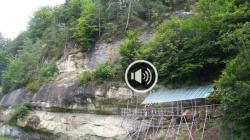 La Souche - Le site archéologique de la Souche, à quelques pas de l'abbaye d'Hauterive, dans le canton de Fribourg, fermera à la fin du mois de septembre. Les lieux sont devenus dangereux après un éboulement de mollasse en début d'année. Le site archéologique de la Souche, à quelques pas de l'abbaye d'Hauterive, dans le canton de Fribourg, fermera à la fin du mois de septembre. Après 10 ans de fouille, les archéologues fribourgeois devront quitter les lieux, devenus dangereux après un éboulement de mollasse en début d'année. Mais ce départ prématuré n'enlève rien aux trésors découverts sur ce campement datant du mésolithique. Les archéologues ont ainsi mis au jour quelque 30'000 silex et 300'000 ossements d'animaux, pour la plupart des restes culinaires. Site d'importance nationale, la fouille de la Souche représente 3 mètres de couches de sédiments sur 2000 ans, datant du mésolithique. Elle témoigne du crépuscule des derniers chasseurs-cueilleurs de l'histoire. La fermeture prématurée du site ne marque toutefois pas la fin de l'étude archéologique. Toutes les pièces récoltées devront désormais être analysées afin de permettre l'étude approfondie de ce lieu préhistorique.
La Souche - Le site archéologique de la Souche, à quelques pas de l'abbaye d'Hauterive, dans le canton de Fribourg, fermera à la fin du mois de septembre. Les lieux sont devenus dangereux après un éboulement de mollasse en début d'année. Le site archéologique de la Souche, à quelques pas de l'abbaye d'Hauterive, dans le canton de Fribourg, fermera à la fin du mois de septembre. Après 10 ans de fouille, les archéologues fribourgeois devront quitter les lieux, devenus dangereux après un éboulement de mollasse en début d'année. Mais ce départ prématuré n'enlève rien aux trésors découverts sur ce campement datant du mésolithique. Les archéologues ont ainsi mis au jour quelque 30'000 silex et 300'000 ossements d'animaux, pour la plupart des restes culinaires. Site d'importance nationale, la fouille de la Souche représente 3 mètres de couches de sédiments sur 2000 ans, datant du mésolithique. Elle témoigne du crépuscule des derniers chasseurs-cueilleurs de l'histoire. La fermeture prématurée du site ne marque toutefois pas la fin de l'étude archéologique. Toutes les pièces récoltées devront désormais être analysées afin de permettre l'étude approfondie de ce lieu préhistorique.
http://www.rts.ch/info/regions/fribourg/4201223-une-fouille-archeologique-devenue-dangereuse-doit-fermer-dans-le-canton-de-fribourg.html
TURQUIE – 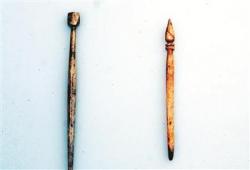 Ayvacık - Archaeologists conducting excavations in the northwestern province of Çanakkale’s Ayvacık district have discovered hairpins thought to be over two millennia old, proving that ancient societies also had a pronounced desire to “look good,” according to researchers. “The hairpins show us that there was a high demand for them in ancient times. Maybe their existence shows us that there was a small atelier for hair pin production here,” said Prof. Nurettin Arslan of Çanakkale Onsekiz Mart University, the head of the excavations, adding that women of the age placed great importance in being well-groomed and stylish. Arslan said the hairpins had been found in many places in the ancient city but that the most were in the agora, which has been the site of the school’s ongoing dig.
Ayvacık - Archaeologists conducting excavations in the northwestern province of Çanakkale’s Ayvacık district have discovered hairpins thought to be over two millennia old, proving that ancient societies also had a pronounced desire to “look good,” according to researchers. “The hairpins show us that there was a high demand for them in ancient times. Maybe their existence shows us that there was a small atelier for hair pin production here,” said Prof. Nurettin Arslan of Çanakkale Onsekiz Mart University, the head of the excavations, adding that women of the age placed great importance in being well-groomed and stylish. Arslan said the hairpins had been found in many places in the ancient city but that the most were in the agora, which has been the site of the school’s ongoing dig.
Noting the unique designs on the hairpins, Arslan said, “They date back to the second century B.C. They are nearly 2,200 year old.” The hairpins were made of various animal bones, the professor said. “Such a material was already a natural one that was used in the ancient era. It was used not only for hairpins but also for necklaces and small spoons. We have found some examples of them in previous excavations.” Arslan said hairpins were the easiest way to differentiate between servants and free women in ancient Greek society. “Dresses [for both sets of women] were the same, but we know that servants had short hair and free women had long hair. We also know that hair models were different in every century. When dating sculptures and coins, we sometimes look at their hair models. In this way, we have chance to make a dating,” he said.
http://www.hurriyetdailynews.com/excavation-reveals-ancient-hair-fashion.aspx?pageID=238&nID=28106&NewsCatID=375
AUSTRALIE – 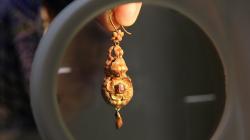
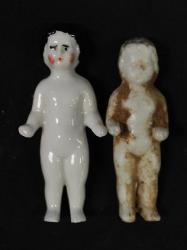
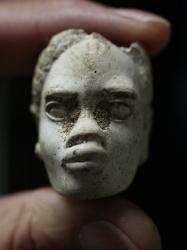 Adelaide - A Victorian era 24-carat gold earring embellished with rubies found underneath 3m of earth at the site of the new Royal Adelaide Hospital on North Tce has ignited debate about its original owner. Some even think it could have belonged to Lady Franklin, the wife of English explorer John Franklin, who lost it when she visited Adelaide. Museum archaeologist Keryn Walshe said the piece had been found at the bottom of a broken wine bottle plugged with soil. The earring would have been far too expensive for anybody who lived or worked at the sheep-yards that lined the area. Excavation of the site has turned up a veritable treasure trove of items, providing a snapshot of Adelaide's past. Dr Walshe, an expert in Aboriginal archaeology, has been archiving the items found at the site during the hospital's construction. Broken crockery, ancient soda bottles, glass beads, a nit comb and corroded sewing implements lie next to animal bones and old clay pipes. A tiny ceramic doll - called Frozen Charlotte - was found in March. The Barbie doll of her time and sold in tiny white coffins as a macabre children's toy, she represents an old American story of a little girl who went out in the snow inadequately dressed and froze to death. A couple of "Negro-head pipes" have also been found - possibly sold as a promotional product in the 1800s. Some items are even older.Aboriginal tools - including a scraper used to make spears - have been found at the site.
Adelaide - A Victorian era 24-carat gold earring embellished with rubies found underneath 3m of earth at the site of the new Royal Adelaide Hospital on North Tce has ignited debate about its original owner. Some even think it could have belonged to Lady Franklin, the wife of English explorer John Franklin, who lost it when she visited Adelaide. Museum archaeologist Keryn Walshe said the piece had been found at the bottom of a broken wine bottle plugged with soil. The earring would have been far too expensive for anybody who lived or worked at the sheep-yards that lined the area. Excavation of the site has turned up a veritable treasure trove of items, providing a snapshot of Adelaide's past. Dr Walshe, an expert in Aboriginal archaeology, has been archiving the items found at the site during the hospital's construction. Broken crockery, ancient soda bottles, glass beads, a nit comb and corroded sewing implements lie next to animal bones and old clay pipes. A tiny ceramic doll - called Frozen Charlotte - was found in March. The Barbie doll of her time and sold in tiny white coffins as a macabre children's toy, she represents an old American story of a little girl who went out in the snow inadequately dressed and froze to death. A couple of "Negro-head pipes" have also been found - possibly sold as a promotional product in the 1800s. Some items are even older.Aboriginal tools - including a scraper used to make spears - have been found at the site.
http://www.adelaidenow.com.au/precious-victorian-ear-gold-and-ruby-earring-dug-up-at-the-new-royal-adelaide-hospital/story-e6frea6u-1226453280613
RUSSIE - 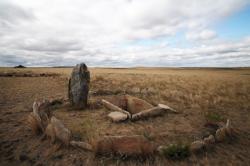 Arkaim - Ancestors of the people who settled Iran and India and founded great global cultures had their beginnings in the Urals region of Russia. In 1987, the Arkaim Valley was slated to become the bottom of a giant reservoir. A dam had already been built, and archeologists were busy wrapping up the kind of exploratory works that are always performed ahead of such operations. It was at that time that a group appeared with news of something strange in the steppe. The archeologists knew they had stumbled upon something big the moment they saw from their plane a giant figure made up of nested circles with lines radiating from the centre. The figure looked like an Indian mandala or a wheel with spokes. Later the experts began to suspect that the ancient town had been built by the very same people who had invented the mandalas – the Aryan tribes that moved into India and Iran. The scientists managed to protect Arkaim and prevent the valley from being flooded and in the early 1990s, it became clear that, 500 years prior to the Trojan War, in the times of the Egyptian pyramids and the rise of Babylon, there was a country of some 20 towns in the Southern Urals, each of which had its own breathtaking citadel. “The Uy River seems to form a natural boundary between the forest-steppe and the steppe. That’s where the Aryan lands begin,” said Gennady Zdanovich, who heads the expedition that excavates the Country of Towns, looking solemnly into the fog. “The Aryan expanse – that’s where their burials mounds are. We have the world’s earliest chariots, which were built a thousand years prior to the Greeks. They’re two-wheel horse-drawn war carts.” Two circles of defensive walls – wooden frames covered in clay. Inside, the houses abut each other and are located radially with their doors on the roofs. All the houses look the same; there do not appear to have been particularly rich or poor families. Each house has a well, and most have a smelt-furnace to make bronze from mixtures of copper and tin ore. Robust bronze gave a powerful impetus to the development of technology and culture, which is why the era is now called the Bronze Age. They made needles and fishhooks from bones, clothing from leather and fabric woven from hemp. They mostly ate cereals with meat and occasionally fish. “The traditional economic model that we are accustomed to now was created at that time – with cattle, small cattle and crop farming,” Zdanovich said. “The most common crops on Arkaim patches were millet, onions and barley.” Cattle were kept outside the citadel, between the walls and the moat. “It was crucial for them to surround themselves with water. The towns were built near a river and encircled with a canal,” Zdanovich said. “This must have had some symbolic significance as well.”
Arkaim - Ancestors of the people who settled Iran and India and founded great global cultures had their beginnings in the Urals region of Russia. In 1987, the Arkaim Valley was slated to become the bottom of a giant reservoir. A dam had already been built, and archeologists were busy wrapping up the kind of exploratory works that are always performed ahead of such operations. It was at that time that a group appeared with news of something strange in the steppe. The archeologists knew they had stumbled upon something big the moment they saw from their plane a giant figure made up of nested circles with lines radiating from the centre. The figure looked like an Indian mandala or a wheel with spokes. Later the experts began to suspect that the ancient town had been built by the very same people who had invented the mandalas – the Aryan tribes that moved into India and Iran. The scientists managed to protect Arkaim and prevent the valley from being flooded and in the early 1990s, it became clear that, 500 years prior to the Trojan War, in the times of the Egyptian pyramids and the rise of Babylon, there was a country of some 20 towns in the Southern Urals, each of which had its own breathtaking citadel. “The Uy River seems to form a natural boundary between the forest-steppe and the steppe. That’s where the Aryan lands begin,” said Gennady Zdanovich, who heads the expedition that excavates the Country of Towns, looking solemnly into the fog. “The Aryan expanse – that’s where their burials mounds are. We have the world’s earliest chariots, which were built a thousand years prior to the Greeks. They’re two-wheel horse-drawn war carts.” Two circles of defensive walls – wooden frames covered in clay. Inside, the houses abut each other and are located radially with their doors on the roofs. All the houses look the same; there do not appear to have been particularly rich or poor families. Each house has a well, and most have a smelt-furnace to make bronze from mixtures of copper and tin ore. Robust bronze gave a powerful impetus to the development of technology and culture, which is why the era is now called the Bronze Age. They made needles and fishhooks from bones, clothing from leather and fabric woven from hemp. They mostly ate cereals with meat and occasionally fish. “The traditional economic model that we are accustomed to now was created at that time – with cattle, small cattle and crop farming,” Zdanovich said. “The most common crops on Arkaim patches were millet, onions and barley.” Cattle were kept outside the citadel, between the walls and the moat. “It was crucial for them to surround themselves with water. The towns were built near a river and encircled with a canal,” Zdanovich said. “This must have had some symbolic significance as well.”
http://rbth.ru/articles/2012/08/20/arkaim_an_ancient_culture_on_the_steppe_17521.html
CHINE – Nan’ao 1 - More than 30,000 pieces of antiques are expected to be salvaged from Nan'ao1, an ancient merchant vessel that sank about 500 years ago off the coast ofGuangdong Province.Upon the conclusion of an underwater archaeological mission, about 10,000 pieces ofnewly salvaged antiques will be exhibited in the Nan'ao Museum in Shantou, saidHuang Yingtao, director of the museum.The salvage operation, which started in June, was suspended due to the effects oftyphoon KaiTak, which made landfall in the coastal area of Guangdong at noon onFriday. This round of underwater archaeological work on Nan'ao1 will finish by the end of September, said Cui Yong, head of the team of archaeologists. Archaeologists conducting the underwater work will measure the length of the wreckafter the antiques are salvaged.Archaeologists had previously recovered over 20,000 antiques, including porcelain andcopper coins, and identified 25 cabins. The ship sank in the Sandianjin waters off Nan'ao County, Shantou, during the mid- orlate-Ming Dynasty (1368-1644). The ship is believed to have been bound for the Philippines and Malaysia, said Cui. Guangdong was a major center for sea trade in ancient China.Local fishermen found the wrecked ship, estimated at 25 meters in length and sevenmeters in width, in May 2007. It was buried in silt 27 meters underwater and about 5.6nautical miles from Shantou. Experts said the antiques salvaged from the Nan'ao1 provide evidence that the"Maritime Silk Road" once existed in the South China Sea.
http://english.people.com.cn/90882/7915861.html
ROYAUME UNI – 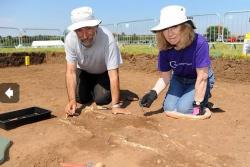 Caistor St Edmund - A headless skeleton thought to date to Anglo Saxon times was uncovered by archaeologists during the first days of a three-week dig outside the walls of Venta Icenorum. Experts believe the head of the body, which may have been of a woman, could have been removed during ploughing of the field because of the shallowness of the grave. Dr Will Bowden, who is leading the project, said: “We think the skeleton is late Roman or Anglo-Saxon, and probably of a fairly small adult, possibly female. “The bones are so fragmented it’s really very difficult to tell, but it’s looking like an isolated burial. Dr Bowden said the dig, which is being carried out in association with the Norfolk Archaeological Trust, had also revealed “tantalising” clues to Caistor’s occupation in the post-Roman period, including parts of timber structures hinting at agricultural or domestic settlement. Discovering definite signs of an Anglo Saxon settlement would be “really important”, he added. “I wouldn’t put bet my house on it, but it’s looking pretty promising,” he said. “None of the other greenfield towns in England have this late occupation. It will be a unique thing to have a confirmed Saxon presence at one of them. “If we have definitely isolated it, it really adds to our knowledge of Roman Britain as a whole.”
Caistor St Edmund - A headless skeleton thought to date to Anglo Saxon times was uncovered by archaeologists during the first days of a three-week dig outside the walls of Venta Icenorum. Experts believe the head of the body, which may have been of a woman, could have been removed during ploughing of the field because of the shallowness of the grave. Dr Will Bowden, who is leading the project, said: “We think the skeleton is late Roman or Anglo-Saxon, and probably of a fairly small adult, possibly female. “The bones are so fragmented it’s really very difficult to tell, but it’s looking like an isolated burial. Dr Bowden said the dig, which is being carried out in association with the Norfolk Archaeological Trust, had also revealed “tantalising” clues to Caistor’s occupation in the post-Roman period, including parts of timber structures hinting at agricultural or domestic settlement. Discovering definite signs of an Anglo Saxon settlement would be “really important”, he added. “I wouldn’t put bet my house on it, but it’s looking pretty promising,” he said. “None of the other greenfield towns in England have this late occupation. It will be a unique thing to have a confirmed Saxon presence at one of them. “If we have definitely isolated it, it really adds to our knowledge of Roman Britain as a whole.”
http://www.edp24.co.uk/news/human_remains_found_at_caistor_st_edmund_1_1486522